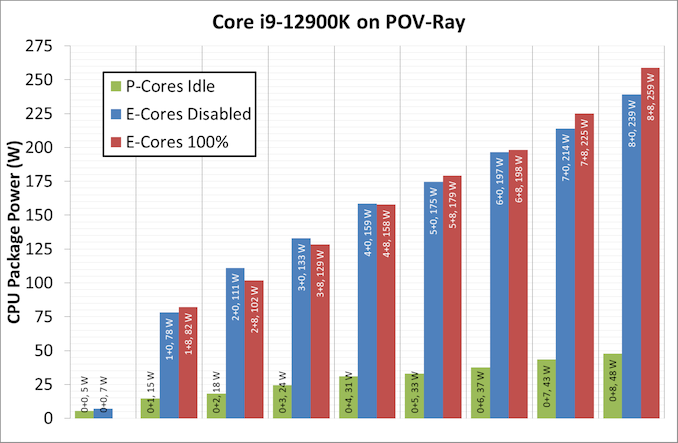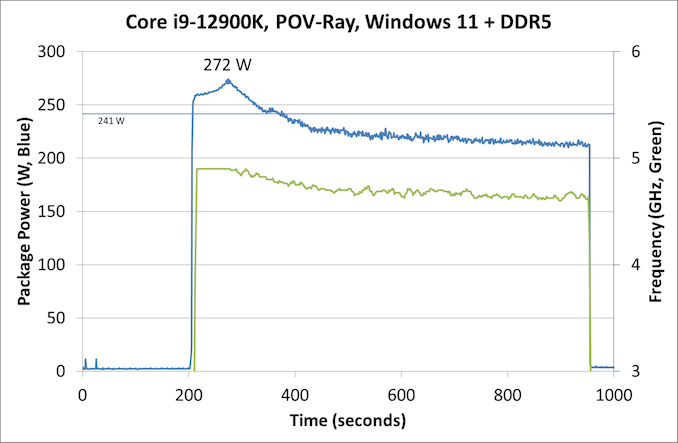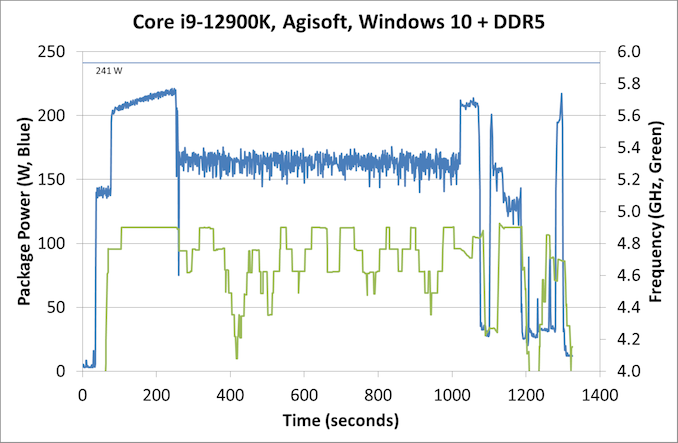The Intel 12th Gen Core i9-12900K Review: Hybrid Performance Brings Hybrid Complexity
by Dr. Ian Cutress & Andrei Frumusanu on November 4, 2021 9:00 AM ESTPower: P-Core vs E-Core, Win10 vs Win11
For Alder Lake, Intel brings two new things into the mix when we start talking about power.
First is what we’ve already talked about, the new P-core and E-core, each with different levels of performance per watt and targeted at different sorts of workloads. While the P-cores are expected to mimic previous generations of Intel processors, the E-cores should offer an interesting look into how low power operation might work on these systems and in future mobile systems.
The second element is how Intel is describing power. Rather than simply quote a ‘TDP’, or Thermal Design Power, Intel has decided (with much rejoicing) to start putting two numbers next to each processor, one for the base processor power and one for maximum turbo processor power, which we’ll call Base and Turbo. The idea is that the Base power mimics the TDP value we had before – it’s the power at which the all-core base frequency is guaranteed to. The Turbo power indicates the highest power level that should be observed in normal power virus (usually defined as something causing 90-95% of the CPU to continually switch) situation. There is usually a weighted time factor that limits how long a processor can remain in its Turbo state for slowly reeling back, but for the K processors Intel has made that time factor effectively infinite – with the right cooling, these processors should be able to use their Turbo power all day, all week, and all year.
So with that in mind, let’s start simply looking at the individual P-cores and E-cores.
Listed in red, in this test, all 8P+8E cores fully loaded (on DDR5), we get a CPU package power of 259 W. The progression from idle to load is steady, although there is a big jump from idle to single core. When one core is loaded, we go from 7 W to 78 W, which is a big 71 W jump. Because this is package power (the output for core power had some issues), this does include firing up the ring, the L3 cache, and the DRAM controller, but even if that makes 20% of the difference, we’re still looking at ~55-60 W enabled for a single core. By comparison, for our single thread SPEC power testing on Linux, we see a more modest 25-30W per core, which we put down to POV-Ray’s instruction density.
By contrast, in green, the E-cores only jump from 5 W to 15 W when a single core is active, and that is the same number as we see on SPEC power testing. Using all the E-cores, at 3.9 GHz, brings the package power up to 48 W total.
It is worth noting that there are differences between the blue bars (P-cores only) and the red bars (all cores, with E-cores loaded all the time), and that sometimes the blue bar consumes more power than the red bar. Our blue bar tests were done with E-cores disabled in the BIOS, which means that there might be more leeway in balancing a workload across a smaller number of cores, allowing for higher power. However as everything ramps up, the advantage swings the other way it seems. It’s a bit odd to see this behavior.
Moving on to individual testing, and here’s a look at a power trace of POV-Ray in Windows 11:
Here we’re seeing a higher spike in power, up to 272 W now, with the system at 4.9 GHz all-core. Interestingly enough, we see a decrease of power through the 241 W Turbo Power limit, and it settles around 225 W, with the reported frequency actually dropping to between 4.7-4.8 GHz instead. Technically this all-core is meant to take into account some of the E-cores, so this might be a case of the workload distributing itself and finding the best performance/power point when it comes to instruction mix, cache mix, and IO requirements. However, it takes a good 3-5 minutes to get there, if that’s the case.
Intrigued by this, I looked at how some of our other tests did between different operating systems. Enter Agisoft:
Between Windows 10 and Windows 11, the traces look near identical. The actual run time was 5 seconds faster on Windows 11 out of 20 minutes, so 0.4% faster, which we would consider run-to-run variation. The peaks and spikes look barely higher in Windows 11, and the frequency trace in Windows 11 looks a little more consistent, but overall they’re practically the same.
For our usual power graphs, we get something like this, and we’ll also add in the AVX-512 numbers from that page:

Compared to Intel’s previous 11th Generation Processor, the Alder Lake Core i9 uses more power during AVX2, but is actually lower in AVX-512. The difficulty of presenting this graph in the future is based on those E-cores; they're more efficient, and as you’ll see in the results later. Even on AVX-512, Alder Lake pulls out a performance lead using 50 W fewer than 11th Gen.
When we compare it to AMD however, with that 142 W PPT limit that AMD has, Intel is often trailing at a 20-70 W deficit when we’re looking at full load efficiency. That being said, Intel is likely going to argue that in mixed workloads, such as two software programs running where something is on the E-cores, it wants to be the more efficient design.














474 Comments
View All Comments
Netmsm - Sunday, November 7, 2021 - link
I believe, we're not talking about ISO-efficiency or manufacturing or engineering details as facts! These are facts but in the appropriate discussion. Here, we have results. These results are produced by all those technological efforts. In fact, those theoretical improvements are getting concluded in these pragmatical information. Therefore, we should NOT wink at performance per watt in RESULTS - not ISO-related matters.So, the fact, my friend, is Intel new architecture does tend to suck 70-80 percent more power and give 50-60 percent more heat. Just by overclocking 100MHz 12900k jumps from ~80-85 to 100 degrees centigrade while consuming ~300 watts.
Once in past, AMD tried to get ahead of Nvidia by 6990 in performance because they coveted the most powerful graphic card title. AMD made the hottest and the noisiest graphic card in the history and now Intel is mimicking :))
One can argue that it is natural when you cannot stop or catch a rival so try to do some chicaneries. As it is very clear that Anandtech deliberately does not tend to put even the nominal TDP of Intel 12900k in their benches. I loathe this iniquitous practice!
Wrs - Sunday, November 7, 2021 - link
@Netmsm I believe the mistake is construing performance-per-watt (PPW) of a consumer chip as indicative of PPW for a future server chip based on the same core. Consumer chips are typically optimized for performance-per-area (PPA) because consumers want snappiness and they are afraid of high purchase costs while simultaneously caring much less than datacenters about cost of electricity.Netmsm - Monday, November 8, 2021 - link
@Wrs You cannot totally separate efficiency of consumer and enterprise chips!As an incontrovertible fact, architecture is what primarily (not completely) determines the efficacy of a processor.
Is Intel going to kit out upcoming server CPUs in an improved architecture?
Wrs - Monday, November 8, 2021 - link
@Netmsm Architecture, process, and configuration all can heavily impact efficiency/PPW. I’m not aware of any architectural reason that Golden Cove would be much less efficient. It’s a mildly larger core, but it doesn’t have outrageous pipelining or execution imbalances. It derives from a lineage of reasonably efficient cores, and they had to be as they remained on aging 14nm. Processwise Intel 7 isn’t much less efficient than TSMC N7, either. (It could even be more efficient, but analysis hasn’t been precise enough to tell.) But clearly ADL in a 12900/12700k is set up to be inefficient yet performant at high load by virtue of high frequency/voltage scaling and thermal density. I could do almost the same on a dual CCD Ryzen, before running into AM4 socket limits. That’s obviously not how either company approaches server chips.Netmsm - Tuesday, November 9, 2021 - link
When you cannot infer or appraise or guess we should drop it for now and wait for real tests of upcoming server chips to come.regards ^_^
GamingRiggz - Tuesday, March 15, 2022 - link
Thankfully you are no engineer.AbRASiON - Thursday, November 4, 2021 - link
AMD would have less of an issue If the 5000 processors weren’t originally priced gouged.Many people held off switching teams due to that. Instead of the processor being an amazing must buy, it was just a decent purchase. So they waited.
If you’re On the back foot in this game, you should be competing hard always to get that stranglehold and mind share.
I’m glad they’re competing though and hopefully they release some very competitive and REASONABLY PRICED products in the near future.
Fataliity - Thursday, November 4, 2021 - link
Their revenue and marketshare #'s beg to disagree.Spunjji - Friday, November 5, 2021 - link
They've been selling every CPU they can make. There are shortages of every Zen 3 based notebook out there (to the extent that some OEMs have cancelled certain models) and they're selling so many products based on the desktop chiplets that Threadripper 5000 simply isn't a thing. You ought to factor that into your assessment of how they're doing.BillBear - Thursday, November 4, 2021 - link
Is anyone gullible enough to forget more than a decade of price gouging, low core counts and nearly nonexistent performance increases we got from Intel, vs. the high core counts, increasing performance, and lower prices we got from AMD?